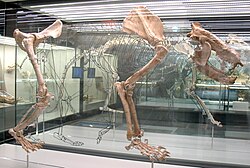Biology:Agriotheriini
| Agriotheriini | |
|---|---|

| |
| Skeletal remains of Indarctos arctoides on display. | |
| Scientific classification | |
| Domain: | Eukaryota |
| Kingdom: | Animalia |
| Phylum: | Chordata |
| Class: | Mammalia |
| Order: | Carnivora |
| Family: | Ursidae |
| Subfamily: | Ailuropodinae |
| Tribe: | †Agriotheriini Hendey, 1972 |
| Genera | |
| Synonyms | |
| |
Agriotheriini is an extinct tribe of ailuropodine bears from the Middle Neogene to Early Quaternary periods with fossils found from Eurasia, Africa and North America. The tribe consists of the genera Agriotherium, Huracan, Indarctos, and possibly Miomaci. The taxonomy of these bears has variously placed some of the genera in other bear lineages such as Hemicyoninae and Ursavinae.[1][2] Recent papers support their inclusion as members of Ailuropodinae based on diagnostic features like large cheek teeth, the fourth premolar with parastyle and enlarged inner lobe, the first and second molars being wide, and the mandible being high in respect to the lower toothrow. Unlike their closest living relative, the giant panda (Ailuropoda melanoleuca) which is a highly specialized bamboo-eater, the evolution of agriotheriins lead to the group being large, hypercarnivorous bears that had adaptations of cursoriality unique in the evolutionary history of bears.[3][4]
References
- ↑ Hunt, R. M. (1998). "Ursidae". in Jacobs, Louis; Janis, Christine M.; Scott, Kathleen L.. Evolution of Tertiary Mammals of North America: Volume 1, Terrestrial Carnivores, Ungulates, and Ungulate like Mammals. Cambridge, UK: Cambridge University Press. pp. 174–195. ISBN 0-521-35519-2.
- ↑ C. Jin, R. L. Ciochon, W. Dong, R. M. Hunt, Jr., J. Liu, M. Jaeger, and Q. Zhu. 2007. The first skull of the earliest giant panda. Proceedings of the National Academy of Sciences 104:10932-10937
- ↑ de Bonis, Louis; Merceron, Juan; Abella, Gildas; Begun, David (October 2017). "A new late Miocene ailuropodine (Giant Panda) from Rudabánya (North-central Hungary)". Geobios 50 (5–6): 413–421. doi:10.1016/j.geobios.2017.09.003. Bibcode: 2017Geobi..50..413D. https://www.sciencedirect.com/science/article/abs/pii/S0016699517300086.
- ↑ Jiangzuo, Q.; Flynn, J. J.; Wang, S.; Hou, S.; Deng, T. (2023). "New fossil giant panda relatives (Ailuropodinae, Ursidae): a basal lineage of gigantic Mio-Pliocene cursorial carnivores". American Museum Novitates (3996): 1–71. doi:10.1206/3996.1. https://zenodo.org/record/8006209.
Wikidata ☰ {{{from}}} entry
 |

